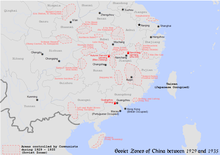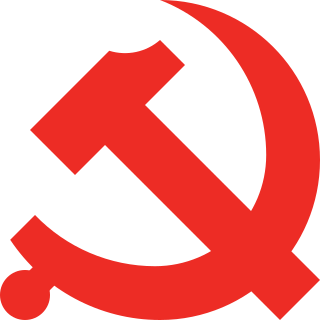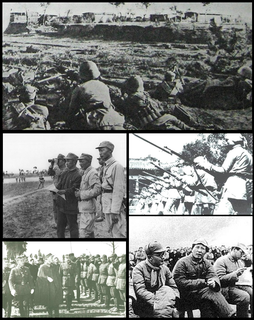
The Encirclement Campaign against the Northeastern Jiangxi Soviet was a campaign launched by the Chinese Nationalist Government intended to destroy the communist Chinese Soviet Republic and its local military forces. It was met by the Communists' Counter-Encirclement Campaign at Northeastern Jiangxi Soviet, also called the Counter-Encirclement Campaign at Northeastern Jiangxi Revolutionary Base. The Nationalist campaign lasted from December 1930 to July 1931, and resulted in the destruction of the target base area.

The Second Encirclement Campaign against the Shaanxi-Gansu Soviet was an encirclement campaign launched by the Chinese Nationalist Government that was intended to destroy the communist Shaanxi-Gansu Soviet and its Chinese Red Army in the local region. It was responded by the Communists' Second Counter-Encirclement Campaign at Shaanxi-Gansu Soviet, also called by the communists as the Second Counter-Encirclement Campaign at Shaanxi-Gansu Revolutionary Base, in which the local Chinese Red Army successfully defended their soviet republic in the border region of Shaanxi and Gansu provinces against the Nationalist attacks from April 1935 to July, 1935.
The First Encirclement Campaign against the Shaanxi-Gansu Soviet was an encirclement campaign launched by the Chinese Nationalist Government that was intended to destroy the communist Shaanxi-Gansu Soviet and its Chinese Red Army in the local region. It was responded by the Communists' First Counter-Encirclement Campaign at Shaanxi-Gansu Soviet, also called by the communists as the First Counter-Encirclement Campaign at Shaanxi-Gansu Revolutionary Base, in which the local Chinese Red Army successfully defended their soviet republic in Shaanxi and Gansu provinces against the Nationalist attacks from March 1934 to 26 August 1934.
The Second Encirclement Campaign against Hubei-Henan-Shaanxi Soviet was a campaign launched by the Chinese Nationalist Government that was intended to destroy the communist Hubei-Henan-Shaanxi Soviet and its local Red Army. It was met with the Communists' Second Counter-Encirclement Campaign at Hubei-Henan-Shaanxi Soviet. The local Red Army successfully defended their territory in the tri-provincial border region from February 1935 to April 18, 1935.
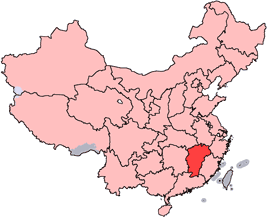
The First Encirclement Campaignagainst Jiangxi Soviet was a series of battles launched by the Chinese Nationalist Government intended to annihilate the Chinese Red Army, and destroy the Chinese Soviet Republic. The communists later responded with the First Counter-Encirclement Campaign at Central Soviet, also called by the communists as the First Counter-Encirclement Campaign at Central Revolutionary Base, in which the Red Army successfully defended the Soviet Republic in the southern Jiangxi province against Nationalist attacks from November 1930 to January 3, 1931.

The Second Encirclement Campaignagainst Jiangxi Soviet was a series of battles launched by the Chinese Nationalist Government in the hope of encircling and destroying the Jiangxi Soviet after the previous campaign had failed. The Red Army repelled the encirclement by launching their Second Counter-Encirclement Campaign, also called by the communists as the Second Counter-Encirclement Campaign at Central Revolutionary Base, in which the local Chinese Red Army successfully defended the Jiangxi Soviet against the Nationalist attacks from April 1, 1931, to May 31, 1931.

The Third Encirclement Campaignagainst Jiangxi Soviet was the third campaign launched by the Chinese Nationalist Government in the hope of destroying the Red Army in Jiangxi. It was launched less than a month after the previous campaign failed. However, this encirclement was repelled by the Red Army's Third Counter Encirclement Campaign at the Central Soviet, also called as the Third Counter-Encirclement Campaign at the Central Revolutionary Base.

The Fourth Encirclement Campaign against the Jiangxi Soviet was the fourth campaign launched by the Chinese Nationalist Government in hope to destroy the Red Army in Jiangxi. The Nationalist headquarters in the provincial border of Jiangxi-Guangdong-Fujian organized nearly 400,000 men, and prepared for another major encirclement on the Chinese Soviet Republic. As a response, the Jiangxi Soviet launched the Fourth Counter Encirclement Campaign at the Central Soviet, also called as the Fourth Counter-Encirclement Campaign at the Central Revolutionary Base. Although the Red Army achieved victory once again, their counter encirclement was not as successful as the previous ones this time, and the Red Army elsewhere suffered considerable loss when many other communist bases were lost, including two major ones.

The Encirclement Campaign against the Hunan-Hubei-Jiangxi Soviet was a campaign launched by the Right-Guomindang Nationalist Government that was intended to destroy the communist Soviet in the Hunan-Hubei-Jiangxi border region and its army. It was responded to with the Communists' Counter-Encirclement Campaign at the Hunan-Hubei-Jiangxi Soviet, also called their Counter-Encirclement Campaign at the Hunan-Hubei-Jiangxi Revolutionary Base. The local red army successfully defended this soviet republic against the government attacks from December 1930 through to May 1931.

The Encirclement Campaign against Hunan-Hubei-Sichuan-Guizhou Soviet was a series of battles launched by the Chinese Nationalist Government that was intended to destroy communist Hunan-Hubei-Sichuan-Guizhou Soviet and its Chinese Red Army in the local region. It was responded by the Communists' Counter-Encirclement Campaign at Hunan-Hubei-Sichuan-Guizhou Soviet, also called by the communists as the Counter-Encirclement Campaign at Hunan-Hubei-Sichuan-Guizhou Revolutionary Base, in which the local Chinese Red Army successfully defended their soviet republic in the southern Jiangxi province against the Nationalist attacks from February, 1935 to August, 1935.
The Second Encirclement Campaign against the Honghu Soviet was a series of battles launched by the Chinese Nationalist Government that was intended to destroy communist Honghu Soviet and its Chinese Red Army in the local region. It was responded by the Communists' Second Counter-Encirclement Campaign at Honghu Soviet, also called by the communists as the Second Counter-Encirclement Campaign at Honghu Revolutionary Base, in which the local Chinese Red Army successfully defended their soviet republic in the Honghu region against the Nationalist attacks from 1 March 1931, to early June, 1931.
The Third Encirclement Campaign against the Shaanxi-Gansu Soviet was an encirclement campaign launched by the Chinese Nationalist Government that was intended to destroy the communist Shaanxi-Gansu Soviet and its Chinese Red Army in the local region. It was responded by the Communists' Third Counter-Encirclement Campaign at Shaanxi–Gansu Soviet, also called by the communists as the Third Counter-Encirclement Campaign at Shaanxi-Gansu Revolutionary Base, in which the local Chinese Red Army successfully defended their soviet republic in the border region of Shaanxi and Gansu provinces against the Nationalist attacks from August 1935 to October 25, 1935. Some Chinese communist historians also consider the Zhiluozhen Campaign fought a month later as part of this 3rd Counter-Encirclement Campaign at Shaanxi–Gansu Soviet.

The Fifth Encirclement Campaign against Jiangxi Soviet was a series of battles fought during the Chinese Civil War from 25 September 1933, to October 1934 between Chiang Kai-shek's Kuomintang (nationalist) and the Chinese communists. During this campaign, the Kuomintang successfully overran the communist Chinese Soviet Republic and forced the communists on the run, an event later known as the Long March. Chiang Kai-shek and the Kuomintang termed this campaign as the Fifth Encirclement Campaign, whilst the Chinese communists termed it as the Fifth Counter Encirclement Campaign at the Central Soviet, also known as the Fifth Counter-Encirclement Campaign at the Central Revolutionary Base or Fifth Extermination Campaign.

The Encirclement Campaign against the Hunan-Western Hubei Soviet was an encirclement campaign launched by the Chinese Nationalist Government that was intended to destroy the communist Hunan-Western Hubei Soviet and its Chinese Red Army in the local region. The Communists' responded by launching the Counter-Encirclement Campaign at Hunan-Western Hubei Soviet, also called by the communists as the Counter-Encirclement Campaign at Hunan – western Hubei Revolutionary Base, in which the Nationalist force defeated the local Chinese Red Army and overran the communist base in the southern Hubei and Hunan provinces from November 1930 to January 1931. Since the bulk of the fighting was fought at the second stage of the campaign, concentrated at the heart of the communist base, the Honghu region of Jingzhou, the campaign is therefore also frequently referred as the Fourth Encirclement Campaign against Honghu Soviet and the Fourth Counter-Encirclement Campaign at Honghu Revolutionary Base by the communists, or Fourth Counter-Encirclement Campaign at Honghu Soviet for short.
The First Encirclement Campaign against the Hubei-Henan-Anhui Soviet was an encirclement campaign launched by the Chinese Nationalist Government that was intended to destroy communist Hubei-Henan-Anhui Soviet and its Chinese Red Army in the local region. It was responded by the Communists' First Counter-Encirclement Campaign at Hubei-Henan-Anhui Soviet, also called by the communists as the First Counter-Encirclement Campaign at Hubei – Henan – Anhui Revolutionary Base, in which the local Chinese Red Army successfully defended their soviet republic in the border region of Hubei – Henan – Anhui provinces against the Nationalist attacks from November 1930 to 9 March 1931.

The First Encirclement Campaign against the Honghu Soviet was an encirclement campaign launched by the Chinese Nationalist Government that was intended to destroy the communist Honghu Soviet and its Chinese Red Army in the local region. It was responded by the Communists' first counter-encirclement campaign at Honghu Soviet, also called by the communists as the first counter-encirclement campaign at Honghu Revolutionary Base, in which the local Chinese Red Army successfully defended their soviet republic in the southern Hubei and northern Hunan provinces against the Nationalist attacks from early December 1930 to the end of January 1931.
The Third Encirclement Campaign against the Hubei-Henan-Anhui Soviet was an encirclement campaign launched by the Chinese Nationalist Government that was intended to destroy communist Hubei-Henan-Anhui Soviet and its Chinese Red Army in the local region. It was responded by the Communists' Second Counter-Encirclement Campaign at Hubei-Henan-Anhui Soviet, also called by the communists as the Second Counter-Encirclement Campaign at Hubei – Henan – Anhui Revolutionary Base, in which the local Chinese Red Army successfully defended their soviet republic in the border region of Hubei – Henan – Anhui provinces against the Nationalist attacks from April 1931 to July 1931.
The Third Encirclement Campaign against the Hubei-Henan-Anhui Soviet was an encirclement campaign launched by the Chinese Nationalist Government that was intended to destroy the communist Hubei-Henan-Anhui Soviet and its Chinese Red Army in the local region. It was responded by the Communists' Third Counter-Encirclement Campaign at Hubei-Henan-Anhui Soviet, also called by the communists as the Third Counter-Encirclement Campaign at Hubei – Henan – Anhui Revolutionary Base, in which the local Chinese Red Army successfully defended their soviet republic in the border region of Hubei – Henan – Anhui provinces against the Nationalist attacks from November 1931 to 17 June 1932.
The Fourth Encirclement Campaign against the Hubei-Henan-Anhui Soviet was an encirclement campaign launched by the Chinese Nationalist Government that was intended to destroy the communist Hubei-Henan-Anhui Soviet and its Chinese Red Army in the local region. It was responded by the Communists' Fourth Counter-Encirclement Campaign at Hubei-Henan-Anhui Soviet, also called by the communists as the Fourth Counter-Encirclement Campaign at Hubei – Henan – Anhui Revolutionary Base, in which the local nationalist force defeated the local Chinese Red Army and overran their soviet republic in the border region of Hubei – Henan – Anhui provinces from early July 1932 to 12 October 1932. However, the Nationalist victory was incomplete because they had concluded the campaign too early in their jubilation, resulting in the bulk of the communist force escaped and established another communist base in the border region of Sichuan and Shaanxi provinces. Moreover, the remnant local communist force of the Hubei-Henan-Anhui Soviet had also rebuilt the local Soviet republic by taking advantage of the early nationalist withdrawal, and as a result, nationalists had to launch another encirclement campaign later to repeat the effort again.
The Fifth Encirclement Campaign against the Hubei-Henan-Anhui Soviet was an encirclement campaign launched by the Chinese Nationalist Government that was intended to destroy the communist Hubei-Henan-Anhui Soviet and its Chinese Red Army in the local region. It was responded by the Communists' Fifth Counter-Encirclement Campaign at Hubei-Henan-Anhui Soviet, also called by the communists as the Fifth Counter-Encirclement Campaign at Hubei – Henan – Anhui Revolutionary Base, in which the local Nationalist force defeated the local Chinese Red Army and overran their soviet republic in the border region of Hubei – Henan – Anhui provinces from 17 July 1933, to 26 November 1934. In mid November 1934, the local communists were forced to abandon their base and begun their Long March, and hence the communists usually choose their beginning of the Long March as the end of the campaign, but in reality, the campaign was longer, lasting for another half a month till the end of November 1934 when the local Chinese Red Army fought its way to escape.
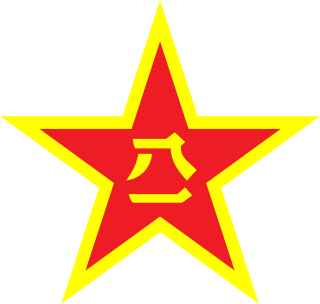
The Chinese People's Liberation Army (PLA) is the armed forces of the People's Republic of China (PRC) and its founding and ruling political party, the Communist Party of China (CPC). The PLA consists of five professional service branches: the Ground Force, Navy, Air Force, Rocket Force, and the Strategic Support Force. Units around the country are assigned to one of five Theater commands by geographical location. The PLA is the world's largest military force and constitutes the second largest defence budget in the world. It is one of the fastest modernising military power in the world and has been termed as a potential military superpower, with significant regional defense and rising global power projection capabilities. China is also the third largest arms exporter in the world.

Beijing, formerly romanized as Peking, is the capital of the People's Republic of China, the world's third most populous city proper, and most populous capital city. The city, located in northern China, is governed as a municipality under the direct administration of central government with 16 urban, suburban, and rural districts. Beijing Municipality is surrounded by Hebei Province with the exception of neighboring Tianjin Municipality to the southeast; together the three divisions form the Jingjinji metropolitan region and the national capital region of China.

The International Standard Book Number (ISBN) is a numeric commercial book identifier which is intended to be unique. Publishers purchase ISBNs from an affiliate of the International ISBN Agency.
